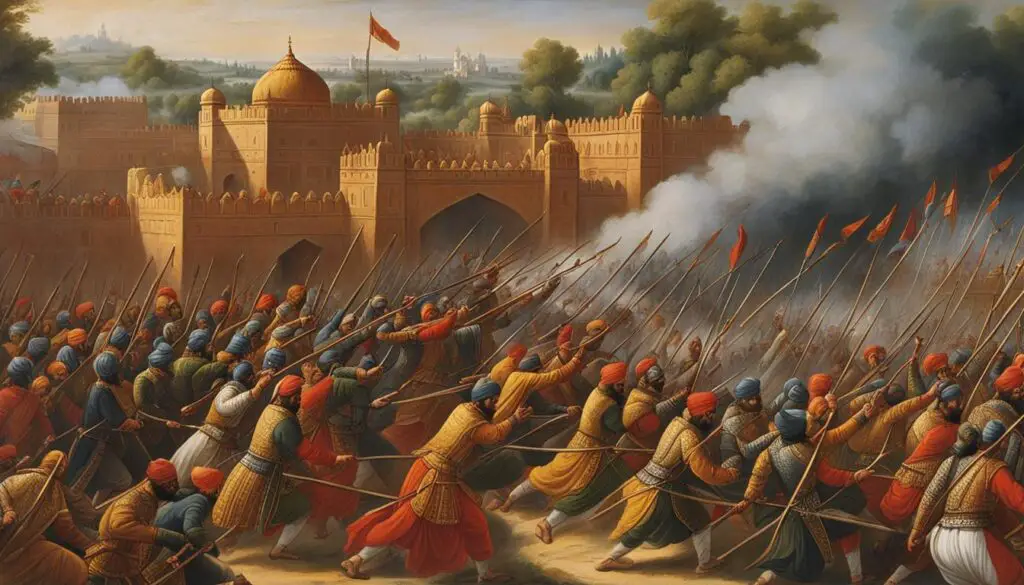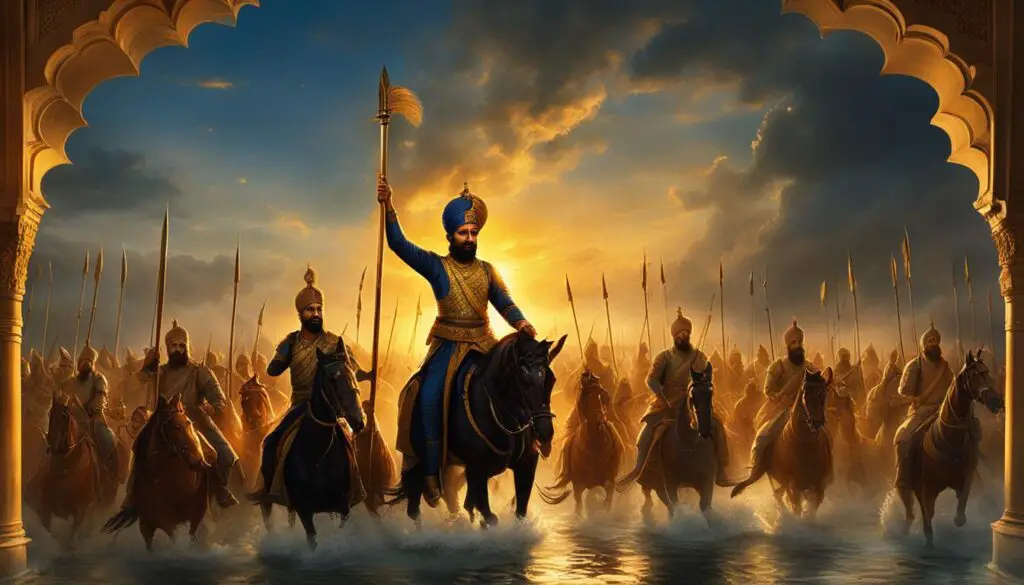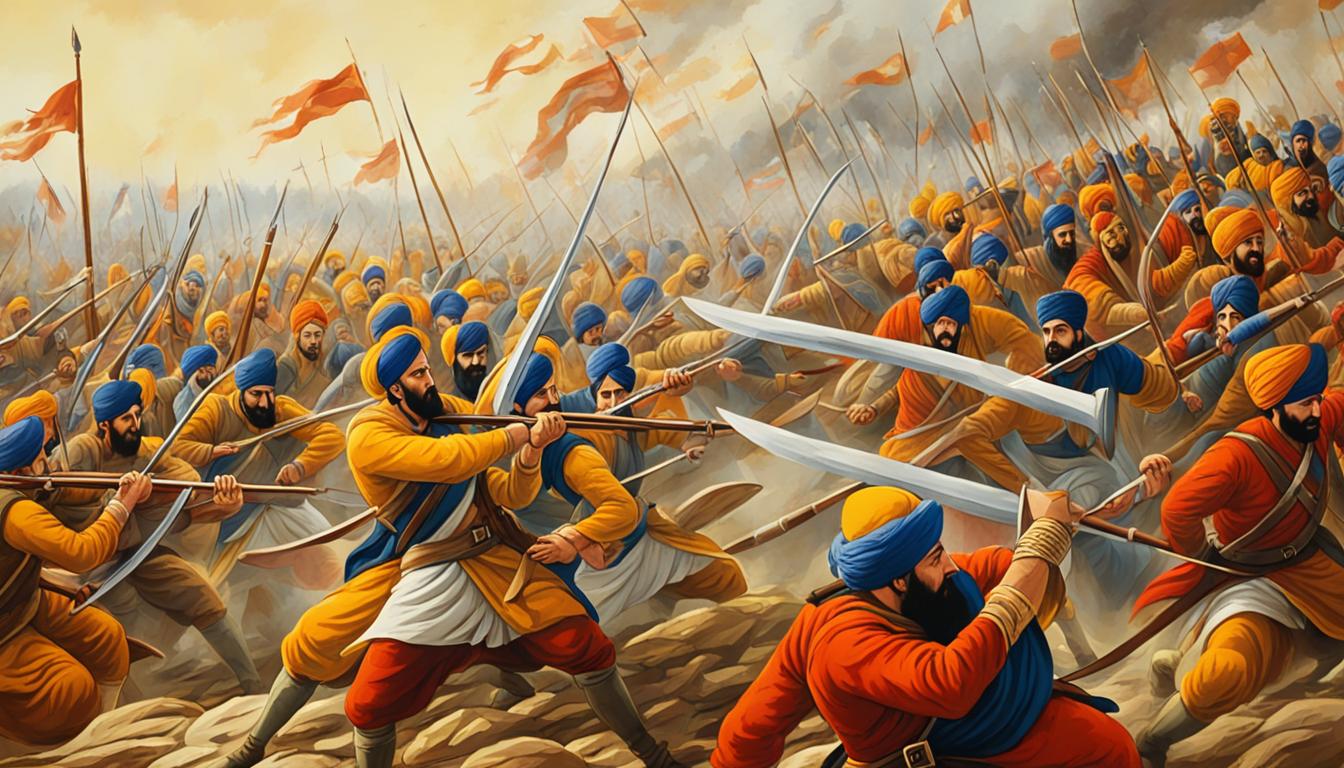Have you ever wondered how a small group of Sikh warriors could emerge victorious against an overwhelming force? In the historic Battle of Chamkaur, the Sikhs faced off against the mighty Mughals and Hindu hill chiefs in a fierce struggle for survival. Despite the odds stacked against them, the Sikh warriors displayed extraordinary valor and strategic brilliance, leading to a defining moment in Sikh history.
Key Takeaways:
- The Battle of Chamkaur was a significant event in the Mughal-Sikh Wars and the Hill States-Sikh Wars.
- The Sikh warriors, led by Guru Gobind Singh, faced a coalition force of Mughals and Hindu hill chiefs.
- Despite being outnumbered, the Sikh warriors showcased courage, strategy, and unwavering faith.
- The Battle of Chamkaur serves as a reminder of the sacrifices made by Guru Gobind Singh and his followers.
- The victory at Chamkaur symbolizes the indomitable spirit and resilience of the Sikh community.
The Siege and Battle of Chamkaur
After leaving Anandpur Sahib, Guru Gobind Singh and his followers sought shelter in Chamkaur. However, the Mughal soldiers, who were looking to capture the Guru, laid siege upon the haveli where he was staying.
The actual battle took place outside the haveli, where the Guru and a small group of Sikhs fought against the overwhelming Mughal forces. Despite the fierce resistance, negotiations broke down and the Sikh soldiers chose to engage the enemy, allowing the Guru to escape.
“Courage is not the absence of fear, but the triumph over it.” – Guru Gobind Singh
The next morning, the remaining Sikhs were killed by the Mughal forces, marking a poignant sacrifice in the face of adversity.

The Aftermath and Zafarnama
After the intense battle at Chamkaur, Guru Gobind Singh took a moment to reflect on the profound sacrifice of his sons and the unwavering bravery of his Sikh warriors. In response to the events that transpired, the Guru penned a letter known as Zafarnama, meaning “Epistle of Victory,” addressing it to Aurangzeb, the Mughal Emperor.
In this powerful letter, Guru Gobind Singh vividly described the events that unfolded during the Battle of Chamkaur, holding Aurangzeb accountable for his broken promises and deceitful actions. The Zafarnama serves as a testament to the Guru’s unwavering spirit and his commitment to upholding Sikh values and principles in the face of adversity.
“O Zafar, how will you escape the consequences of your actions? God is the true master of all; He observes the struggles of the innocent.”
Guru Gobind Singh’s Zafarnama is a powerful declaration of victory in the face of defeat. It not only expressed the Guru’s deep discontent and disappointment with Aurangzeb’s conduct but also served as a reminder of the indomitable spirit of the Sikh community. Through this letter, Guru Gobind Singh conveyed his unwavering faith and pride in his sons, who laid down their lives for the sake of righteousness.
The Impact of Zafarnama
The Zafarnama became a significant document in Sikh history, shedding light on the courage and resilience of Guru Gobind Singh and his followers. It serves as a symbol of the Sikh community’s determination to uphold justice and fight against oppression.
The Zafarnama remains an important piece of literature, inspiring generations of Sikhs to stand up against injustice and hold true to their principles. It stands as a testament to the immortal legacy of Guru Gobind Singh and continues to resonate with Sikhs around the world.

| Key Highlights of Zafarnama | Significance |
|---|---|
| The letter was written in Persian, highlighting the Guru’s literary prowess and ability to communicate effectively with the Mughal Empire. | The Zafarnama encapsulates the spirit of Sikh resistance and stands as a powerful critique of Aurangzeb’s oppressive rule. |
| The Guru expressed his disappointment with Aurangzeb’s broken promises, challenging the Emperor’s authority and demanding justice. | The Zafarnama reflects the fearlessness and fearfulness of the Sikh community, united against oppression and injustice. |
| The letter acknowledges the sacrifice of the Guru’s sons and the dedication of his followers, reaffirming their commitment to Sikh values. | It stands as a clarion call for all Sikhs to uphold truth, justice, and the principles enshrined in Sikhism. |
Conclusion
The Battle of Chamkaur stands tall in Sikh history as a defining moment of courage and resilience. Despite overwhelming odds and challenging circumstances, the Sikh warriors demonstrated unwavering faith and unwavering commitment to their cause.
Throughout the battle, Guru Gobind Singh and his followers exemplified the indomitable spirit of the Sikh community. Their unwavering determination and sacrifice continue to inspire Sikhs around the world.
The victory at Chamkaur serves as a testament to the Sikh’s unwavering commitment to their principles and their ability to overcome adversity. It symbolizes the defining moment where Sikhs stood strong against injustice, leaving an indelible mark in Sikh history.
FAQ
What was the Battle of Chamkaur?
The Battle of Chamkaur was a significant event in Sikh history, fought between the Khalsa led by Guru Gobind Singh and the coalition forces of the Mughals led by Wazir Khan and Hindu hill chiefs. It took place during the Mughal-Sikh Wars and the Hill States-Sikh Wars.
What happened during the Siege of Chamkaur?
After leaving Anandpur Sahib, Guru Gobind Singh and his followers sought shelter in Chamkaur. However, the Mughal soldiers, who were looking to capture the Guru, laid siege upon the haveli where he was staying. The actual battle took place outside the haveli, where the Guru and a small group of Sikhs fought against the overwhelming Mughal forces.
How did the battle at Chamkaur unfold?
Despite being outnumbered, the Sikh warriors displayed great courage and strategy in their fight against the larger Mughal forces. Negotiations broke down, and the Sikh soldiers chose to engage the enemy, allowing the Guru to escape. The next morning, the remaining Sikhs were killed by the Mughal forces.
What is Zafarnama, and what role does it play?
Zafarnama, meaning “Epistle of Victory,” is a letter written by Guru Gobind Singh to Aurangzeb, the Mughal Emperor. In the Zafarnama, the Guru vividly described the events at Chamkaur and held Aurangzeb responsible for broken promises and lies. It serves as a testament to the bravery and sacrifice of his sons and reaffirms his commitment to Sikh values.
Why is the Battle of Chamkaur significant?
The Battle of Chamkaur holds great significance in Sikh history as a defining moment of courage and determination. Despite being outnumbered, the Sikh warriors showcased their unwavering faith and commitment to the Sikh cause. It symbolizes the indomitable spirit and resilience of the Sikh community and continues to inspire Sikhs around the world.
Source Links
- https://en.wikipedia.org/wiki/Battle_of_Chamkaur
- https://bootcampmilitaryfitnessinstitute.com/2020/12/06/what-was-the-battle-of-chamkaur-1704/
- https://asiasamachar.com/2015/12/23/5238/

